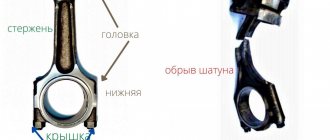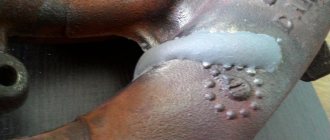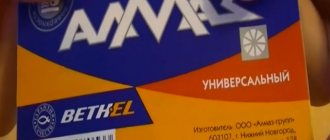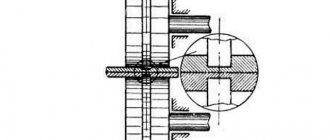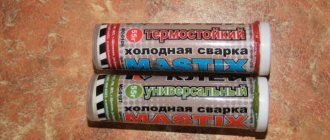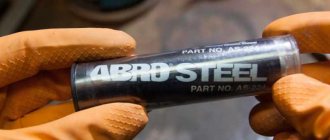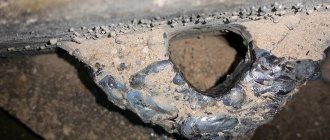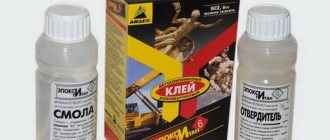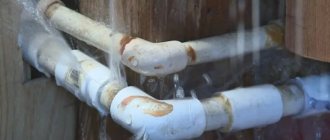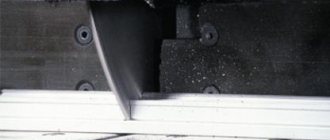Aluminum is considered one of the most common metals at the moment. This metal is used in various industries due to its characteristics. However, it is not always possible to join aluminum parts by welding. A bolted connection will be unreliable for this metal. Because of this, cold welding for aluminum has become very popular.
High-tech joining of aluminum with “Cold Welding” glue
Cold welding of aluminum is the joining of parts using a special adhesive mixture. Thanks to it, a reliable connection is obtained without heating the metal.
An epoxy compound acts as a binding mixture. It is a thick mass, the consistency of which resembles mastic. Cold welding for aluminum consists of epoxy resin saturated with metal powder. Due to its content in the resin, the strength of the hardened composition increases. The glued area can be stronger than the material itself.
In addition to the main component (epoxy resin), the package contains a second component. This is a special hardener that, when mixed with epoxy, reacts and the composition begins to harden. In a period of time from 10 to 30 minutes, the master must have time to apply resin to the parts and connect them. Next, you need to press the individual parts together for 15-20 minutes (in some adhesives, the fixation time for hardening reaches 40 minutes).
Advice! It is advisable to begin further work 2-3 hours after applying the adhesive mixture. As a rule, you need to wait at least a day for the epoxy resin to completely harden.
It is important to remember that both high-temperature and cold welding are harmful processes that require individual protection of the human body. When interacting with adhesives, the room must be well ventilated and there is no open fire nearby. To protect your respiratory system, you should wear a respirator. To avoid irritation of the mucous membrane of the eye, it is advisable to wear safety glasses. If epoxy resin is swallowed, you should go to the hospital immediately.
Adhesive mixtures have a number of serious advantages:
- There is no need to buy additional equipment or look for network connection points.
- Anyone can work with epoxy resin without any skills. The packages contain step-by-step instructions. The same cannot be said about welding using electrical equipment.
- The hardened glue forms a strong seam, which is slightly inferior to welded joints.
- Hardened compounds are resistant to corrosion processes, moisture, oils and fuel.
- After 20-60 minutes, a strong connection is obtained.
- Cold welding is considered an economical option for repairing a variety of equipment.
When using automatic welding machines, the metal being joined is exposed to high temperatures and severe deformation. Cold welding does not have these disadvantages. However, glue cannot be used when repairing high-pressure vessels and containers that are often subject to changes in the environment (humidity, temperature).
Brief characteristics of silumin
Silumin is a metal alloy based on aluminum. Cutlery, dishes, containers for storing food, drinking water, sanitary fittings, and building materials are made from it. The main components of the alloy are aluminum and silicon. The content of the second element can reach 22% of the total mass. Additionally, third-party additives may be added to the composition to change the technical characteristics.
Physical, chemical properties:
- Material density - 3g/cm3.
- Melting point - 580 °C.
- High plasticity.
- Low strength.
The popularity of silumin is explained by its main advantage - resistance to rust formation. When exposed to open air, an oxide film appears on metal surfaces, which protects them from environmental factors.
ASTROhim cold welding for aluminum, Total Bond series
ASTROhim – cold welding for aluminum. Used for various types of repair work. In addition to aluminum, this composition effectively joins wood, steel and ceramic parts in various combinations.
Stages of performing work using ASTROhim cold welding:
- Clean work surfaces from dirt and dust. Remove rust using sandpaper, degrease and dry.
- Next, you need to wet your hands under running water, cut off part of the epoxy rod, mix it with the hardener and knead it in your palms.
- Apply the prepared composition to the surfaces to be bonded. Press them for 15 minutes.
If you need to restore the thread, you need to spread the prepared mixture on the old part of the thread and screw in the bolt. After 20 minutes you need to unscrew the bolt. You can use the finished thread after 90 minutes.
Characteristics:
- The pot life of the mixture after mixing the components is 7 minutes. The room temperature should be about +20° C.
- Setting time: 20 minutes.
- Other work can be carried out after 1.5 hours.
- Retains its properties at temperatures from -60 to +150° C.
The glue hardens faster when heated and slower when the temperature drops.
This series produces “ASTROhim heat-resistant cold welding” - high-temperature cold welding for aluminum and silumin. Reliably repairs parts made of other non-ferrous and ferrous metals, as well as ceramics, operating temperature from -60° C to +250° C.
Solders for aluminum
Aluminum can be soldered with both ordinary lead-tin solders and special ones containing aluminum, zinc, silver and other metals and even non-metals (for example, silicon). POS solders, like those special for aluminum, have different melting temperatures, which must be taken into account both when working with them and when operating the repaired product.
If you decide to solder dishes that come into contact with food (canister, flask, distiller tube, etc.), then solders containing lead cannot be used. You will have to do high temperature soldering , using, for example, 34A solder, containing copper, silicon and, of course, aluminum. TsOP-40 containing zinc is suitable.
Solders 34A (left) and TsOP-40
Among the foreign ones, we can recommend Aluminum-13, which, in fact, is an analogue of 34A.
Solder for soldering aluminum Aluminum-13
Another option is soldering with pure tin. It is great for repairing food utensils and has a low melting point, which means the work can be done with a soldering iron. But when using tin, make sure that the soldering area does not get too hot during the operation of the product. For example, you can seal the bottom of a kettle with tin (it comes into contact with water and will not heat up above 100 degrees), but the beak of the same kettle will fall off after the first boil.
Tin can be used to solder food utensils
The so-called fluxed ones, which already contain a special flux (usually in the form of a coating, but not necessarily), deserve special attention. There is an opinion that flux is not needed at all to work with them and, in principle, this is true. Nevertheless, it is very desirable for protecting the soldering area from oxidation during operation. Any passive flux that can withstand soldering temperatures is suitable for these purposes. The ideal solution here would be ordinary transformer oil, which electricians use when soldering high-voltage couplings.
Sealant (cold welding) Anles Uniplast-universal 20g aluminum
Epoxy plasticine, supercompound. Anles Uniplast-universal is a cold welding based on aluminum. Used for fastening workpieces made of various metals (non-ferrous and ferrous), restoring threads, repairing plumbing pipes and fuel storage tanks. This is a two-component composition, which consists of a hardener and epoxy resin. The base is further strengthened with aluminum or bronze dust.
Stages of working with Anles Uniplast-universal:
- The working surface is cleaned of dirt and rust. Processed with sandpaper. Then the surface is degreased and dried.
- The hardener and base must be cut in equal parts, mixed until a homogeneous mass is obtained and applied to the parts to be glued.
- Secure the gluing area with a rope or place it under a weight.
It is recommended to continue work after 24 hours. Has high electrical insulating properties.
Characteristics:
- The viability of the finished composition is about 25 minutes. Temperature +20° C.
- The maximum strength of the connection occurs after a day.
- Cold welding is resistant to prolonged exposure to water, gasoline and oils.
- Withstands temperatures from -40 to +120° C.
You need to work with this glue in a well-ventilated area and away from sources of fire.
Useful tips
Recommendations from experts will help you choose the most suitable composition for gluing aluminum, as well as make the connection of surfaces as high-quality and reliable as possible:
- Aluminum structures can be completely glued together with a two-component composition based on epoxy resin. But if you need to join the surfaces of an alloy that contains aluminum, then it is better to prefer a product containing methyl acrylate.
- For aluminum, only a special composition containing acids and alkalis is suitable. These components ensure the splitting of the oxide film, which significantly improves the adhesion of the adhesive.
- The use of epoxy resin-based adhesives is strictly prohibited if the product will in the future be used to store drinking water or food or come into contact with them.
The means used for gluing aluminum do not provoke oxidation of the metal, unlike gas welding. As a result, the repaired product will last much longer. Another positive point is the low cost of cold welding.
Silumin is an aluminum alloy with a high silicon content. It is used to make parts of complex configurations. Cold and hot methods are used to restore them.
Silumin welding is carried out in several ways: with consumable and refractory electrodes. The metal oxidizes easily, so it is advisable to use a protective atmosphere. The quality of the connection suffers without it. This is due to heat-resistant aluminum oxides. Experienced welders will tell you how to weld metal and what subtleties are important to take into account.
Weicon Repair Stick ST Aluminum. Repair rod
Weicon Repair Stick ST Aluminum is a repair stick that is used to repair plumbing pipes, repair visual damage to the trim of ships, boats, cars and window frames. The rod consists of epoxy resin with copper filler. Refers to repair sticks.
Weicon Repair Stick ST Aluminum Cold Welding Steps:
- The surface of the parts to be joined is cleaned of dirt, treated with sandpaper, and degreased.
- Using a stationery knife, you need to cut off the required part from the rod, wet your hands and knead the glue in your fingers.
- Apply to the broken part and press for 20 minutes.
It is advisable to continue working with the glued product after a day.
Characteristics:
- At 20 degrees, the pot life of the composition is 4 minutes.
- Resistant to temperatures from -50 to +120° C.
- Total curing time is 24 hours.
You can work with the adhesive from +10 to +35° C.
How to use the mixtures?
Those who do not know how to glue aluminum at home should follow the following sequence of actions:
- Rust and dirt are removed from the surface of the joined areas using fine-grained sandpaper or a brush.
- Next, the surfaces are treated with acetone.
- After this, you need to wait a while for the area to dry.
- Mix glue and hardener in a separate container. You should get a homogeneous viscous mass.
- The adhesive mixture must be applied to the surface in the form of dots or thin strips. Then the parts are pressed tightly against each other. They need to be fixed in this position and left for 15-20 minutes.
If you have any excess, you can remove it with a rag previously soaked in solvent.
Cold welding “Fast steel” METALFIX LAVR 60g
“Fast steel” METALFIX LAVR is a two-component mixture that is used to join ferrous and non-ferrous metals, concrete, wood, plastic, granite and various polymer materials. This cold welding is also used to repair plumbing pipes, repair cars and industrial equipment.
Application:
- The surfaces of the parts to be glued are cleaned of dust and rust. Next, it is processed using coarse sandpaper.
- Surfaces need to be degreased and dried.
- Cut off a piece of epoxy resin and knead it thoroughly in your palms.
- Apply the mixture to the surfaces to be glued, rub it to the desired shape with any flat object.
To continue work, you only need to wait 1.5 hours. Not inferior in strength to a welded seam. Eliminates leaks in gas tanks, radiators, engine crankcases and gearboxes.
Characteristics:
- The glue partially sets in 15 minutes.
- Resistant to prolonged exposure to moisture and oils.
- Complete hardening is achieved after a day.
- Withstands temperatures from -60 to +150° C.
- It is advisable to have time to apply cold welding within 10 minutes.
Aluminum Putty F (Devcon F), metal polymer filled with aluminum
Aluminum Putty F (Devcon F) is a two-component composition that is saturated with aluminum powder. Used for joining non-ferrous metals, as well as plastic and concrete. With this cold welding it is possible to create aluminum surfaces that are resistant to corrosive processes.
Application:
- Initially, the surfaces of the parts to be glued are cleaned of paint, dirt and rust. Remaining oil and grease must be removed using a solvent. When working with aluminum products, you need to clean it before applying cold welding.
- If work is carried out at a temperature less than +10° C, the surfaces are heated to +40° C.
- On a flat board, mix the base and hardener using a spatula. They also apply the finished glue to the parts.
- Treat the finished product with wet sandpaper.
When applying glue, you need to press it into the voids and cracks of the material. This type of cold welding can be used to repair containers that will contain gasoline or oil.
Characteristics:
- Start mechanical work on the glued product after curing no earlier than 4 hours later. After 16 hours at room temperature, it reaches 75% readiness for use.
- Resistant to corrosive processes. Protects metal.
- When fully prepared, it retains its properties at temperatures up to +120° C.
- The glue can be applied within 60 minutes.
Devcon F compounds are chemically resistant to water, salt solutions, gasoline, petroleum products, oil and propylene glycol. Not suitable for prolonged contact with concentrated acids and organic solvents.
Advantages and disadvantages of silumin argon arc welding
- unlike other methods of restoring parts made of silumin, using an arc in an argon atmosphere produces more durable connections;
- seam formation mode is high-speed, welding does not take much time;
- no need to preheat parts and electrode;
- proven technology suitable for beginners;
- the directed arc does not overheat the part, it does not deform.
- work cannot be carried out in open space; in enclosed spaces, drafts must be avoided so that the argon cloud remains above the work area;
- it is difficult to immediately select the welding mode;
- when working with thick-walled metal, you need to consider a method of heat removal;
- you need to have special equipment.
For those who regularly carry out repair work, the disadvantages of argon welding do not prevent them from creating high-quality and reliable connections.
Parts of various shapes made of aluminum and silicon alloy are famous for their increased wear resistance and strength. This alloy is called silumin.
What is it, what are the features of welding products at home, how to solder silumin parts? We will look at the answers to these questions in the article.
Cold welding - epoxy multi-purpose compound Permatex GOLD WELD
“Permatex GOLD WELD” is a multi-purpose compound, an epoxy-based mixture. Used for joining various metals, plastics, ceramics, glass, wood, rubber and various polymers. Apply using a tube. The application process is similar to applying instant glue. Recommended for rigid connections and pouring forms.
Characteristic:
- The hardened composition is resistant to the destructive effects of alkalis and acids.
- Resistant to corrosive processes.
- Hardens in 4 minutes. Partial curing time is 10 minutes.
- The finished product can withstand temperatures up to +177° C for a short time.
This cold welding is resistant to physical impact and vibration. Because of this, it is used to repair industrial equipment. Main applications: aluminum, steel, brass, bronze and copper. The product is resistant to most automotive, industrial and cleaning fluids.
How can you glue aluminum and glass?
How and with what to glue metal to glass
- Two-component epoxy adhesive. ...
- Silicone with high thermal stability. ...
- A product called Moment Crystal. ...
- Automotive adhesive resembles rubber in its basic characteristics.
Interesting materials:
How to care for a store-bought rose in a pot? How to care for small roses? How to care for a mini rose? How to care for a climbing rose in the country? How to care for Climbing Rose in the first year? How to care for a purchased rose in a pot? How to care for a purchased rose? How to care for roses from the store? How to care for roses after planting in spring? How to care for roses after planting?
Deformation welding technology features
When aluminum pieces are joined at room temperature, this method is called “cold welding.” In addition to the use of adhesive compositions, which were described above, there is the principle of deformation. This technology consists of several key stages:
- Aluminum surfaces are initially degreased.
- Next, the workpieces are brought as close as possible and compressed under pressure.
During the compression process, the outer oxidized layer is destroyed. Intermolecular bonds are formed between the crystal lattices of the metal. This ensures a reliable connection.
Hydraulic Cold Welding Machine for Aluminum and Copper
This technology can be used to bond other non-ferrous metals. Pressure can be applied uniformly or vibration can be added. Based on deformation technology, three connection methods can be distinguished, which will be described in more detail below.
How to brew silumin
So, for welding silumin, argon arc technology is required. The equipment includes an inverter, a gas cylinder, an oscillator and a special burner. A non-consumable tungsten electrode is installed in the burner. Silumin wire should act as an additive here.
Before starting the welding process, silumin blanks must be prepared. The basic rule is to remove the oxide film.
- First, you need to clean the edges of the parts to be welded using sandpaper, a wire brush, a sandblaster or any other method.
- Next, chemical treatment is carried out. This can be any solvent, gasoline or caustic soda solution. If the latter material is used, then after processing it is recommended to rinse the metal workpieces with water pressure.
Welding is done with reverse polarity and a short arc. This can only be explained by the fact that with a short arc the metal melts better. The filler wire is fed into the welding zone, where it is also melted and combined with the base metal, ultimately forming a single, homogeneous liquid substance. When it cools, it turns into a monolith.
It is impossible to quickly feed the additive into the weld pool. This will lead to metal spattering, which will reduce the quality of the weld. The wire must be fed in front of the burner and held at an angle. The movement and feed must be uniform exactly along the seam. Do not deflect the filler rod or move it across. An even and narrow seam is a high quality connection.
Everything else, in principle, is exactly the same as when welding aluminum. Namely:
- When igniting the electrode, do not touch the metal workpieces being welded.
- Gas supply must begin 15 seconds after ignition of the tungsten electrode. This will ensure heating of the space in the burner nozzle.
- When finishing welding, do not stop the gas supply. Shutdown can be carried out after 10 seconds, when the power supply to the electrode is turned off. This will ensure uniform cooling of the metal in the gap between the workpieces.
At home, you can weld silumin with a consumable electrode. For example, consumables from the well-known Swedish company ESAB brand OK 96.50. But here too there is some specificity.
- The blanks are prepared in the same way.
- Pre-welded parts are heated to 250-300C.
- The electrodes are also preheated to 150C.
Butt method
This technique is one of the most reliable in terms of cold welding of aluminum. Suitable for connecting parts through their ends. This way you can combine the plates into one large shield. The process of metal bonding occurs in several stages:
- First of all, the ends of the parts are cleaned. Paint, rust and dirt are removed from them. Next they are degreased.
- After cleaning, the parts are clamped in a special vice located opposite each other. Only the ends and 1 cm of metal should stick out.
- When the workpieces are securely fastened in a vice, end pressure is transmitted through them to the ends. With its help, a reliable connection is obtained.
Technologically, this is a simple and low-cost process that is accessible to any craftsman working with metal. However, it has significant drawbacks.
Firstly, the size of the holding vice does not allow the use of large parts for joining. Secondly, part of the metal clamped in a vice is also subject to deformation. Thirdly, after cold butt welding is completed, it is difficult to remove the finished part from the clamps.
Features of silumin alloy
It is stronger than duralumin, resistant to corrosion, ductile - easily stamped, castable and forged.
It is valued for its decorativeness, wear resistance, and lightness (it has a low specific gravity). Silumin is used in many industries; parts for cars and motorcycles, overhead elements for plumbing, and interior decoration are made from it.
Due to oxidative activity, the aluminum-silicon alloy is difficult to weld. In general, alloys with a high zinc content are not welded; when heated, it burns out and the metal becomes brittle. Foundry silumin with a silicon content of 5 to 22% is hot joined. During heat treatment, inert gases are used, mainly argon; it is heavier than air, settles on the workpiece, and is held in a cloud.
Point technology
With this cold welding method, aluminum sheets can be overlapped. It is considered the most popular technology of the three presented. Bonding process:
- The parts are placed on top of each other and pressed on both sides with special clamps.
- The punches are located at a certain interval, to which the precision pressure will be transferred.
- A force is transmitted to the punches, which presses them into the metal.
The strength of the connection will depend on how hard the punch is pressed into the metal and what material these point elements are made of. Also important is the number of points in the connecting line.
The main advantage of spot cold welding is low deformation of the part. It occurs only at the points of contact of the elements through which pressure is transmitted to the aluminum.
Suture method
An effective cold welding technique that involves creating a continuous seam using special equipment.
It consists of two rollers, between which parts are secured. The rollers are located parallel to each other. Punches or a special ring are attached to their working part. These elements form the joining seam. Seam welding can be divided into two types:
- One-sided - one roller rotates, the other is firmly fixed in one position.
- Double-sided - two rollers are driven by electric motors.
The process of fastening metal sheets:
- The area that will be fastened is initially degreased and cleaned of dirt and rust.
- The parts are pressed between the rollers.
- After the engine starts, they begin to rotate and drive parts through the working part. This results in a smooth, uniform seam.
Metallurgists often join large sheets of aluminum and other non-ferrous metals in this way. However, it must be remembered that continuous seams reduce the strength of the overall part. Because of this, the suture technique has been modernized over time. In the process of technology development, the point-suture connection method appeared. It involves installing punches on rollers, which make the seam divided into many points. This way it turns out much stronger.
Principles of working with adhesives and gluing instructions
The rules for using special compounds for joining aluminum surfaces provide for the following points:
- work is carried out in conditions of sufficient ventilation of the space, since the products contain caustic compounds with toxic components;
- it is necessary to use personal protective equipment, work in gloves, a respirator and safety glasses;
- Before starting the procedures, you should ensure that you have the equipment and materials required by the instructions.
At the initial stage, it is advisable to prepare the surfaces, clean them from dirt and dust, and degrease them for better adhesion. To do this, you need to have a brush with stiff bristles, abrasive, acetone and rags on hand.
Step-by-step instructions for gluing aluminum products:
- Surfaces are cleaned of dirt, rust and plaque using a metal brush or grinder with a special brush attachment.
- The joint areas must be sanded using fine-grained sandpaper.
- Degrease the coating with acetone.
- Combine the adhesive composition with the hardener according to the manufacturer's instructions, mix the components until a homogeneous mass is formed. The finished mixture must be used for its intended purpose within the time specified by the manufacturer, which varies between 10-60 minutes depending on the brand.
- The glue is applied to both surfaces in a thin strip or dotted.
- Next you need to connect the elements and press them tightly against each other.
- Excess adhesive is removed with a rag.
Next, you should fix the position of the structure for the period specified in the instructions until the connecting mixture hardens.
